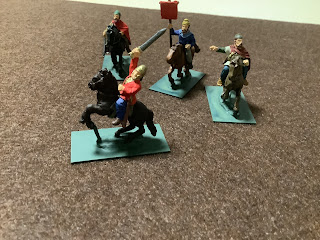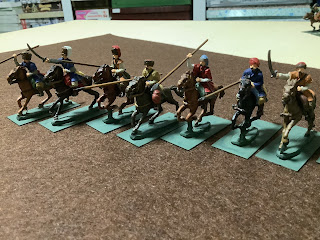Baden 1806-1815
Baden joined the Confederation of the Rhine in 1806 and immediately began to re-organise its army on the French pattern. By 1809 the army consisted of the Gardes du Corps squadron, a regiment of light dragoons, one of hussars, a corps of artillery with one horse and two foot companies. A Lieb Garde grenadier battalion, a jager battalion and four regiments of line infantry, the first of these being the Leib regiment. In 1808 the 4th regiment was re-organised for service in Spain and the 1st battalion of that regiment was exchanged for the 2nd battalion of the 3rd regiment. It is most likely that the new 3rd and 4th regiments retained the flags of the old regiments of the same number. The infantry Regiments consisted of two battalions, each of which was issued with a flag, the 1st battalion carried the Leibfahne, the 2nd the Regimentersfahne. The Liebfahnen were withdrawn in 1808, except possibly from the 2nd regiment. The flags were carried on plain wooden staves with brass finials. I have been unable to ascertain the dimensions of these flags and standards and so have used 130 x 130 cm for the infantry flags and roughly 100cm square for the cavalry standardswhich looks about right. Sources conflict as to the exact design of flag carried by the Leib or 1st infantry regiment so I have included both possibilities here - let the wargamer decide! The Gardes du Corps squadron had a vexillum standard mounted on a white horizontal bar and stave, the finial (in the form of a griffon) and chains were silver. The Hussar and Light Dragoon regiments each had a single standard which were carried on plain wooden staves with brass spear shaped finials.
Divider
The Infantry Flags from top to bottom:
1st or Leib regiment pattern one
1st or Lieb regiment pattern two
2nd regiment
3rd regiment
4th regiment
Liebfahne on left, Regimenterfahne on right
The Cavalry Standards from top to bottom:
The Garde du Corps vexillum
Note: The colouring used here is largely conjectural
The hussar regiment
The light dragoon regiment

Bavarian Infantry 1786 - 1815
The flags carried by the Bavarian regiments underwent many changes during the Napoleonic Wars. At any one time the flags carried by the army included examples issued in the previous century, more recent issues which had been altered as the status of Bavaria changed, or completely new issues. Details of which regiment carried which particular pattern and at what time are unknown. However it is certain that as late as 1812 the regiments carried flags of all the patterns and variants presented here.
At the turn of the 18th century Bavarian infantry regiments carried one Leibfahne and one Ordinarfahne, the Leibfahne was carried by the 1st Battalion. In October 1801 this was changed to two Leib- and two Ordinarfahnen. In December 1803 the scale of issue was changed to one Leib- and three Ordinarfahnen, and in March 1804 to one Leib- and one Ordinarfahne, carried by the 1st and 2nd field battalions respectively. Two flags per regiment remained the norm for the remainder of the Napoleonic period.
All flags issued before 1813 were carried on staves with a light blue velvet covering, the flags issued in 1813 had staves covered in black leather. All staves were topped by a gilt spear-shaped finial which was either pierced or engraved with the cypher of the elector or king. The ferrules were also gilt. Gold fringed blue and white cravats 1.06 metres long by 18cm wide were tied beneath the finials. These cravats were usually plain, however some richly embroidered examples were presented by colonels and senior officers to some regiments.
The Flags from top to bottom:
First Row: 1786 Patterns. Note - the coat of arms is based on an incomplete written description and so represents my best guess!
If anyone out there knows better.....
Second Row: Patterns issued sometime between 1800 and 1803.
Third Row: 1803 Patterns - The plain Ordinarfahne was also issued to some regiments in 1813.
Fourth Row: 1806 Patterns.
Fifth Row: 1808 Patterns.
Ordinarfahnen on left, Leibfahnen on right.
Variations on a Theme
Divider
The flags issued during the period 1800 to 1806 usually had a triple row of lozengy for the border as shown above. However the border of some flags was increased to four rows whilst on some others it was reduced to two rows. The plain pattern flag issued in 1803 and re-issued in 1813 could have either vertical rows of lozengy as shown above or horizontal rows as below. I have included these variants here so that the user can cut and paste to produce which ever variation they require - let the wargamer decide.
Brunswick Infantry 1815
I have been unable to discover what flags, if any, where carried by the Brunswick troops prior to 1814. During the Waterloo campaign in 1815, the three Light battalions, the Leib battalion, the Avantgarde battalion and the cavalry units were not issued with standards. The three Line battalions carried two flags each, The Herzogfahne (Duke's flag) and the Bataillonfahne (Regimental flag), the patterns for these varied from battalion to battalion. All the flags were carried on a three metre long staff topped by a gilt spear-shaped finial bearing the ducal monogram. Mixed yellow and silver cords and tassels were attached immediately below the finial. Dimensions for the flags of the 1st and 2nd battalions were 140cm square, whilst those of the 3rd battalion were 144cm X 150cm for the Bataillonfahne and 142cm square for the Herzogfahne. I have drawn all the flags at a scale 150cm square so those requiring strict accuracy should adjust for this when resizing.
divider
Below: Top to Bottom, 1st, 2nd and 3rd Line Battalions
Herzogfahne on left, Bataillonfahne on right
The Danish Auxiliary corps 1813
A treaty of alliance between Denmark and France was signed on the 10th July 1813. The treaty dictated that Denmark would supply a force known as the "the Danish Auxiliary corps" which, together with three smaller French divisions made up the newly created French XIII army-corps commanded by Marshal Davout. The Danish contingent consisted of the following:
The Queens Life regiment of foot 1st Battalion
Oldenburg Infantry regiment 1st, 2nd and 4th Battalions
Schleswig Infantry regiment 1st and 2nd Battalions
Holstein Infantry regiment 3rd and 4th Battalions
3rd Jutland Infantry regiment 1st Battalion
Fyenen Infantry regiment 1st and 2nd Battalions
Schleswig Jaeger corps 2nd Battalion
Holstein Sharpshooter corps 1st and 2nd Battalions
3rd company of Slesvigske Jaeger corps
The Light company of the Queens Life regiment of Foot 2nd Battalion
The Light company of the Oldenburg Infantry regiment 3rd Battalion
The Hussar Regiment 2nd and 6th Squadrons
Holstein Cavalry regiment 4 squadrons
2nd Fyenen light dragoons regiment 4 squadrons
Battery Gerstenberg (a 6-pounder battery of foot. 10 guns)
Battery Koye (a 6-pounder battery of foot. 10 guns)
Battery Friis (a 6-pounder battery of foot. 10 guns)
Battery Gönner (a 3-pounder mounted battery. 10 guns)
In all about 10,200 men.
In 1813 the Danish infantry regiments consisted of four battalions each of which seems to have been issued with at least one and possibly as many as four pairs of flags (possibly one pair per company), a pair consisted of a king's colour and a regimental colour. It seems that the light infantry regiments were not issued with flags. The cavalry regiments consisted of four squadrons each of which carried an identical squadron standard, the cavalry do not appear to have been issued with king's colours.
Infantry Flags from top to bottom:
The Queens Life regiment of foot
Oldenburg Infantry regiment
Schleswig Infantry regiment
Holstein Infantry Regiment
3rd Jutland Infantry Regiment
Fyenen Infantry regiment
Regimental colour on left, Kings colour on right




















